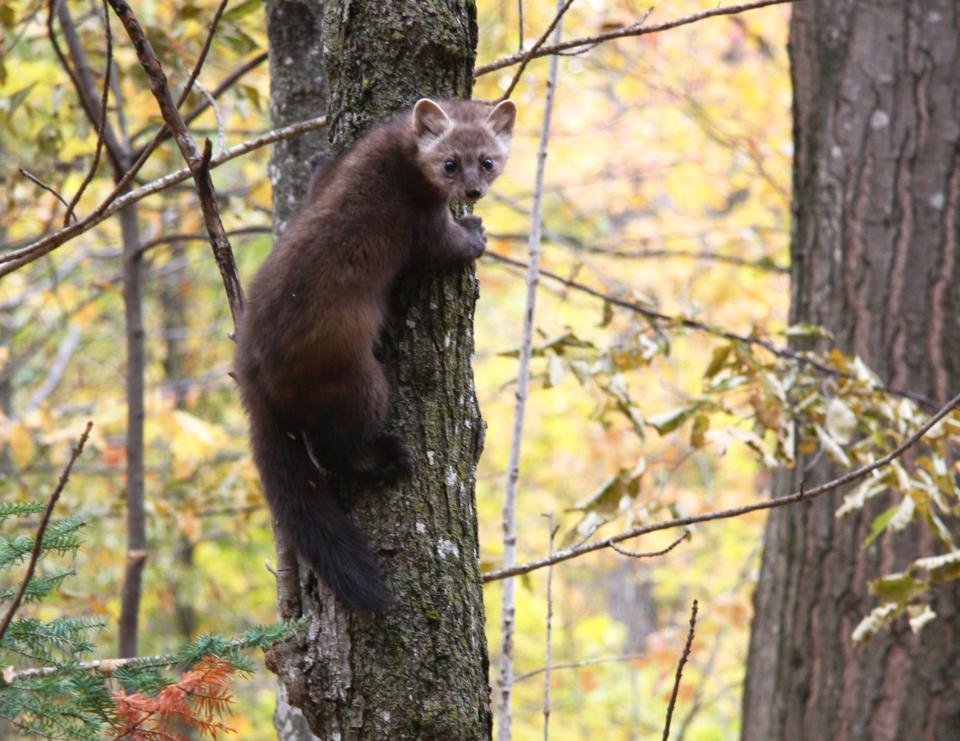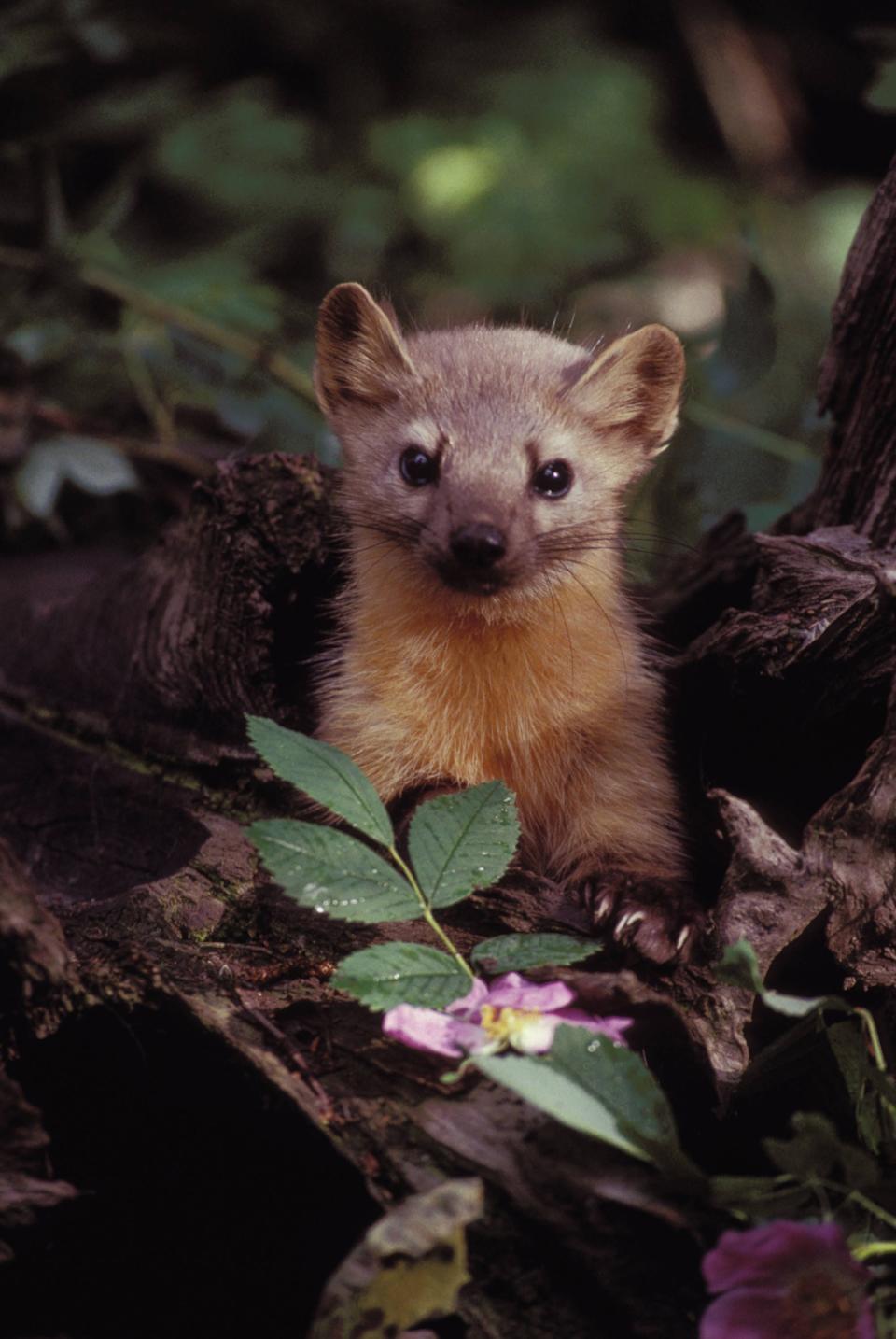Smith: A marten on Madeline Island is part of positive trend for endangered species

The 25 trail cameras set out by Northland College researchers on Madeline Island filled their roles in 2022.
As part of a project to study the island's wildlife called "Wild Madeline," the digital devices had triggered at motion and captured thousands of images of animals.
But that was only the data collection part of the research.
The workload then shifted to Northland College staff and students, led by associate professor of natural resources Erik Olson, to download, view, identify and catalog the photos.
It's a painstaking job on an immense volume of data. But every so often it can produce a remarkable finding.
More: Outdoors calendar
This spring as research assistant and Northland College junior Sydni Bennette scrolled through "camera trap" images collected the previous year she saw many of the common species found in the Apostle Islands. The tally included black bears, coyotes, white-tailed deer and red squirrels.
But a series of photos collected after dark in July 2022 was different from any she'd seen from Madeline.
There, toward the back of the scene, was a small animal, standing erect and facing the camera, its eyes shining beneath outsized ears.
Bennette recognized it as an American marten, a state-endangered species.
She also understood its significance.
“I was astonished," said Bennette, a student in Northland's Natural Resources Program. "I couldn’t believe the discovery we just made.”

American martens, also known as pine martens, probably haven't been on Madeline Island since the early 1900s
Olson, who has worked on marten projects for more than a decade and has seen the species in the hand and on trail cam images, agreed with the identification.
And to have a pair of non-Northland eyes take a look, Olson sent the images to Jonathan Gilbert, a marten researcher and director of biological services with the Great Lakes Indian Fish and Wildlife Commission. Gilbert confirmed it.
A network of wildlife researchers and advocates ranging from academia to state and federal agencies and tribes savored a rare "yes!" moment.
It was the first evidence of a marten on Madeline Island in contemporary times, Olson said.
"Think about it," Olson said. "Martens likely haven't been on Madeline since the early 1900s."
What's an American marten?
The American marten is one of the smallest members of the mustelid family. It weighs about 2 pounds and is about 15 inches long. It is mostly solitary and nocturnal and primarily preys on other small mammals, including red squirrels and small rodents.
The species is primarily found in mature northern forests and dens in hollow trees, crevices or vacant ground burrows.
The marten is native to Wisconsin and other northern areas of North America but was extirpated from most areas of Wisconsin, including the Apostle Islands, due to intense logging and habitat degradation.
The American marten is the only mammal on the state list of endangered species (the gray wolf if federally listed as endangered).
The marten has been the focus of several reintroduction efforts over the last 75 years. Ten Pacific marten were introduced to the Apostle Islands from Montana and British Columbia in the 1950’s but didn't survive; the last was detected in 1969, according to Jonathan Pauli, marten researcher and professor in the Department of Forest and Wildlife Ecology at the University of Wisconsin.
On the mainland additional reintroduction efforts took place between 1970 and 2010 when about 200 marten were transferred from Ontario to the Chequamegon-Nicolet National Forest. This work was successful at creating a network of marten populations across northern Wisconsin and the upper peninsula of Michigan, Pauli said.
Reintroduced martens have been seen on other islands in the Apostles
And some of these animals or their offspring dispersed to the Apostle Islands, likely over the ice.
The Apostles are a chain of 22 islands off the northern tip of Wisconsin in Lake Superior.
In 2014 an American marten was observed on Manitou Island. A photograph later surfaced of a marten taken in 2010 on the island.
The sightings led to a series of projects by UW-Madison and Northland College researchers to try to determine what islands in the archipelago had marten populations and where the animals originated.
The work was an extension of the partnerships formed over many years to support marten research in Wisconsin, Pauli said. Other partners include the Department of Natural Resources, Great Lakes Fish and Wildlife Commission, Bad River and Red Cliff bands of Ojibwe, National Park Service and U.S. Forest Service.

Through a variety of techniques, including DNA analyses of hair samples collected in "hair snares," it was found the Apostle Island martens came from the mainland, Pauli said.
And prior to last year camera traps documented at least one marten on 11 of the 22 Apostle Islands.
The marten population in Wisconsin remains low. Work in the eastern portion of the Chequamegon-Nicolet National Forest in 2015 estimated 80 of the animals. And over recent years projects have produced an estimate of 50 in the Apostles, Pauli said.
"The Apostles seem to be providing high-quality habitat," Pauli said. "And we now think the marten populations on the islands could help serve as a source back to areas of the mainland. It's a pretty remarkable development."
The finding on Madeline Island makes 12 islands in the archipelago with a verified marten sighting.
The Northland College researchers had trail cameras on Madeline starting in Oct. 2016. None of the work had seen a marten until July 2022.
The marten captured as part of the Wild Madeline project was a "pretty recent arrival" on the island, Olson said.
"Are there more?" Olson said. "Will they establish a breeding population on the island? Those are questions we're working on and can't wait to find out."
This article originally appeared on Milwaukee Journal Sentinel: American marten found on Madeline Island for first time in 100 years

